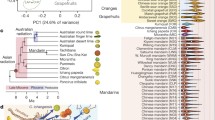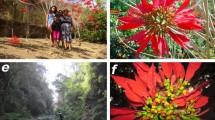Abstract
Numerical studies of morphological data and starch gel electrophoresis have provided a new perspective on important issues pertinent to the origin(s) and subsequent evolution of domesticatedCucurbita pepo. Wild C.texana and/orC. fraterna appear to be the most likely candidates for progenitor(s) of the domesticate. Populations of texana-like plants from beyond Texas share various attributes with Texas populations, suggesting that C. texana once had a more widespread distribution to the northeast. The possibility exists thatC. pepo was domesticated independently in eastern U.S., as well as in Mexico, which is in line with recent archeological findings. Multiple domestications are also supported by allozyme data indicating a substantial divergence within the species. A new classification consisting of C.pepo ssp.pepo (origins in Mexico),C. pepo ssp.ovifera var. ovifera (origins in eastern U.S.), and C.pepo ssp.ovifera var. texana (spontaneous populations in eastern U.S.) is proposed.
Similar content being viewed by others
Literature Cited
Alefeld, F. 1866. Landwirtschaftliche Flora. Wiegandt and Hempel, Berlin.
Andres, T. C., M. Nee, N. F. Weeden, and J. Wyland. 1986. Rediscovery ofCucurbita fraterna Bailey, the alleged “brother” toC. texana. Paper presented at the 27th annual meeting of the Soc. Econ. Bot.
Asch, D. L., and N. E. Asch. 1985. Prehistoric plant cultivation in west-central Illinois. Pages 149–204in R. I. Ford, ed., Prehistoric food production in North America. Pap. Mus. Anthropol., Univ. Michigan 75.
Bailey, L. H. 1929. The domesticated cucurbitas. Gentes Herb. 2:62–115.
— 1937. The garden of gourds. Macmillan, New York.
— 1943. Species of Cucurbita. Gentes Herb. 6:267–322.
Bemis, W. P., A. M. Rhodes, T. W. Whitaker, and S. G. Carmer. 1970. Numerical taxonomy applied toCucurbita relationships. Amer. J. Bot. 57:404–412.
Burgess-Terrel, M. E. 1979. A study ofCucurbita material from Salmon Ruin, New Mexico. M.S. thesis, Eastern New Mexico Univ., Portales.
Candolle, A. P. de. 1828. Prodromus 3:316–318.
Carter, G. F. 1945. Plant geography and culture history in the American Southwest. Viking Fund Publ. in Anthropol. 5, New York.
Castetter, E. F. 1925. Horticultural groups of cucurbits. Proc. Amer. Soc. Hort. Sci. 22:338–340.
Chomko, S. A., and G. W. Crawford. 1978. Plant husbandry in prehistoric eastern North America: new evidence for its development. Amer. Antiquity 43:405–408.
Conard, N., D. L. Asch, N. B. Asch, D. Elmore, H. Gove, M. Rubin, J. A. Brown, M. D. Wiant, K. B. Farnsworth, and T. G. Cook. 1984. Accelerator radiocarbon dating of evidence for prehistoric horticulture in Illinois. Nature 308:443–446.
Correll, D. S., and M. C. Johnston. 1979. Manual of the vascular plants of Texas. Univ. Texas, Dallas. (Reprint of a work first published in 1970.)
Cowan, C. W. 1985. Understanding the evolution of plant husbandry in eastern North America: lessons from botany, ethnography and archaeology. Pages 205–244in R. I. Ford, ed., Prehistoric food production in North America. Pap. Mus. Anthropol., Univ. Michigan 75.
Cutler, H. C., and T. W. Whitaker. 1961. History and distribution of the cultivated cucurbits in the Americas. Amer. Antiquity 26:469–485.
Dane, F. 1983. Cucurbits. Pages 369–390in S. D. Tanksley and T. J. Orton, eds., Isozymes in plant genetics and breeding, Part B. Elsevier, Amsterdam.
Decker, D. S. 1985. Numerical analysis of allozyme variation inCucurbita pepo. Econ. Bot. 39:300–309.
—. 1986. A biosystematic study ofCucurbita pepo. Ph.D. dissertation, Texas A&M Univ., College Station.
-, and L. A. Newsom. n.d. Numerical analysis of archaeologicalCucurbita seeds from Hontoon Island, Florida. (Submitted to J. Ethnobiol. in Mar. 1987.)
—, and H. D. Wilson. 1986. Numerical analysis of seed morphology inCucurbita pepo. Syst. Bot. 11:595–607.
—. 1987. Allozyme variation in theCucurbita pepo complex:C. pepo var.ovifera vs.C. texana. Syst. Bot. 12:263–273.
Denna, D. W., and M. B. Alexander. 1975. The isoperoxidases ofCucurbita pepo L. Pages 851–864in C. L. Markert, ed., Isozymes II: Physiological function. Academic Press, New York.
Erwin, A. T. 1938. An interesting Texas cucurbit. Iowa State Coll. J. Sci. 12:253–255.
—, and E. W. Haber. 1929. Species and varietal crosses in cucurbits. Iowa Agric. Exp. Sta. Bull. 263:344–372.
Ford, R. I. 1980. ‘Artifacts’ that grew: their roots in Mexico. Early Man 2:19–23.
—. 1985. Patterns of prehistoric food production in North America. Pages 341–364in R. I. Ford, ed., Prehistoric food production in North America. Pap. Mus. Anthropol., Univ. Michigan 75.
Golf, E. S. 1888. Report of the horticulturist. New York Agric. Exp. Sta. Annual Rep. 6:76–342.
Gray, A. 1868. Field, forest and garden botany. American Book, New York.
Harlan, J. R. 1951a. Anatomy of gene centers. Amer. Naturalist 85:97–103.
—. 1951b. New World crop plants in Asia Minor. Sci. Monthly 72:87–89.
Harrison, S., L. R. Oliver, and O. Bell. 1977. Control on Texas gourd in soybeans. Abstract. Proc. Southern Weed Sci. 30:46.
Heiser, C. B., Jr. 1979. The gourd book. Univ. Oklahoma Press, Norman.
—. 1985a. Of plants and people. Univ. Oklahoma Press, Norman.
—. 1985b. Some botanical considerations of the early domesticated plants north of Mexico. Pages 57–72in R. I. Ford, ed., Prehistoric food production in North America. Pap. Mus. Anthropol., Univ. Michigan 75.
Hurd, P. D., Jr., E. G. Linsley, and T. W. Whitaker. 1971. Squash and gourd bees (Peponapis, Xenoglossa) and the origin of the cultivatedCucurbita. Evolution 25:218–234.
Ignart, F., and N. F. Weeden. 1984. Allozyme variation in cultivars ofCucurbita pepo L. Euphytica 33:779–785.
King, F. B. 1985. Early cultivated cucurbits in eastern North America. Pages 73–98in R. I. Ford, ed., Prehistoric food production in North America. Pap. Mus. Anthropol., Univ. Michigan 75.
Kirkpatrick, K. J. 1983. Gene flow inCucurbita. Texas A&M Archives, College Station.
—. 1984. The relationship between isozyme phenotype and morphological variation inCucurbita. M.S. thesis, Texas A&M Univ., College Station.
—, D. S. Decker, and H. D. Wilson. 1985. Allozyme differentiation in theCucurbita pepo complex:C. pepo var.medullosa vs.C. texana. Econ. Bot. 39:289–299.
Linnaeus, C. 1753. Species plantarum. Impensis Laurentii Salvii, Stockholm.
-. 1767. Mantissa plantarum. Impensis Laurentii Salvii, Stockholm.
Mohlenbrock, R. H., and D. M. Ladd. 1978. Distribution of Illinois vascular plants. Southern Illinois Univ. Press, Carbondale.
Naudin, C. 1856. Nouvelles recherches sur les caracteres specifiques et les varietes des plantes du genreCucurbita. Ann. Sci. Nat. IV. Bot. 6:5–73.
Newsom, L. A. 1986. Plants, human subsistence, and environment: a case study from Hontoon Island (8-VO-202), Florida. M.S. thesis, Univ. Florida, Gainesville.
Puchalski, J. T., and R. W. Robinson. 1978. Comparative electrophoretic analysis of isozymes inCucurbita species. Cucurbit Gen. Coop. Rep. 1:28.
Rhodes, A. M., W. P. Bemis, T. W. Whitaker, and S. G. Carmer. 1968. A numerical taxonomic study ofCucurbita. Brittonia 20:251–266.
Smith, E. B. 1978. An atlas and annotated checklist of the vascular plants of Arkansas. Univ. Arkansas Press, Fayetteville.
Steyermark, J. A. 1963. Flora of Missouri. Iowa State Univ. Press, Ames.
Story, D. A. 1985. Adaptive strategies of Archaic cultures of the West Gulf Coastal Plain. Pages 19–56in R. I. Ford, ed., Prehistoric food production in North America. Pap. Mus. Anthropol., Univ. Michigan 75.
Struever, S., and K. D. Vickery. 1973. The beginnings of cultivation in the Midwest-Riverine area of the United States. Amer. Anthropol. 75:1197–1220.
Sturtevant, E. L. 1890. The history of garden vegetables. Amer. Naturalist 24:719–744.
Tapley, W. T., W. D. Enzie, and G. P. van Eseltine. 1937. The vegetables of New York, Vol. 1, Part IV, The cucurbits. N.Y. Agric. Exp. Sta., Geneva.
Vavilov, N. I. 1949–1950. The origin, variation, immunity, and breeding of cultivated plants. Chron. Bot. 13.
Wall, J. R. 1969. A partial survey of the genusCucurbita for electrophoretic variants of esterase and leucine aminopeptidase. Southw. Naturalist 14:141–148.
—, and T. W. Whitaker. 1971. Genetic control of leucine aminopeptidase and esterase isozymes in the interspecific crossCucurbita equadorensis x C. maxima. Biochem. Genet. 5:223–229.
Watson, P. J. 1985. The impact of early horticulture in the upland drainages of the Midwest and Midsouth. Pages 99–148in R. I. Ford, ed., Prehistoric food production in North America. Pap.n Mus. Anthropol., Univ. Michigan 75.
Whitaker, T. W. 1947. American origin of the cultivated cucurbits. Ann. Missouri Bot. Gard. 34:101–111.
—. 1968. Ecological aspects of the cultivatedCucurbita. HortScience 3:9–11.
—. 1974.Cucurbita. Pages 135–144in R. C. King, ed., Handbook of genetics, Vol. 2. Plenum Press, New York.
—, and W. P. Bemis. 1964. Evolution in the genusCucurbita. Evolution 18:553–559.
—. 1975. Origin and evolution of the cultivatedCucurbita. Bull. Torrey Bot. Club 102:362–368.
—, and G. F. Carter. 1946. Critical notes on the origin and domestication of the cultivated speciesof Cucurbita. Amer. J. Bot. 33:10–15.
—, and H. C. Cutler. 1965. Cucurbits and cultures in the Americas. Econ. Bot. 19:344–349.
—. 1971. Prehistoric cucurbits from the Valley of Oaxaca. Econ. Bot. 25:123–127.
—, and R. S. MacNeish. 1957. Cucurbit materials from three caves near Ocampo, Tamaulipas. Amer. Antiquity 22:352–358.
—, and G. N. Davis. 1962. Cucurbits. Interscience Publ., New York.
—, and I. C. Jagger. 1937. Breeding and improvement of cucurbits. Yearb. Agric. 1937:207–232.
—, and R. J. Knight, Jr. 1980. Collecting cultivated and wild cucurbits in Mexico. Econ. Bot. 34:312–319.
Willdenow, C. L. 1805. Species plantarum, 4th ed., vol. 4. Impensis G. C. Nauk, Berlin.
Zhiteneva, N. E. 1930. The world’s assortment of pumpkins. Trudy Prikl. Bot. 23(3): 157–207. (In Russian with three-page summary in English.)
Author information
Authors and Affiliations
Rights and permissions
About this article
Cite this article
Decker, D.S. Origin(s), evolution, and systematics ofCucurbita pepo (Cucurbitaceae). Econ Bot 42, 4–15 (1988). https://doi.org/10.1007/BF02859022
Received:
Accepted:
Issue Date:
DOI: https://doi.org/10.1007/BF02859022




